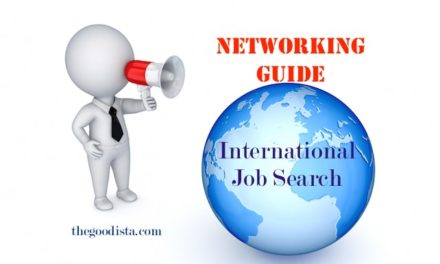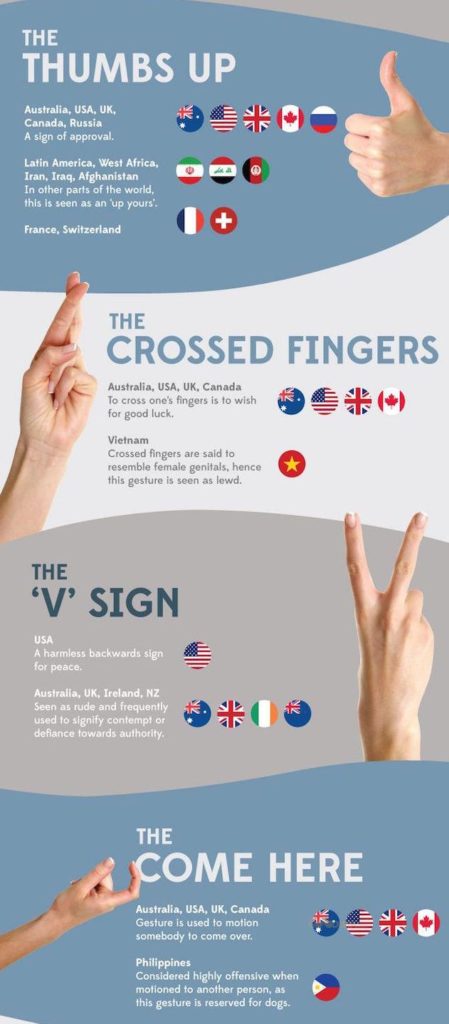 Communication barriers are common, especially when you work, or live, in different cultures far away from family and friends. What works at home doesn’t come across which creates challeges. Communication barriers lead to misunderstandings, conflict, perception errors and (as we all know) relationship issues. Knowing which are the most common barriers can build bridges. You can make your life a lot easier if you understand how to interpret a gesture, or not to get thrown by a tone of voice. Emotionally charged situations can easily be avoided if we learn how to straighten out question marks.
Communication barriers are common, especially when you work, or live, in different cultures far away from family and friends. What works at home doesn’t come across which creates challeges. Communication barriers lead to misunderstandings, conflict, perception errors and (as we all know) relationship issues. Knowing which are the most common barriers can build bridges. You can make your life a lot easier if you understand how to interpret a gesture, or not to get thrown by a tone of voice. Emotionally charged situations can easily be avoided if we learn how to straighten out question marks.
Read on to get to grips with cross border communication and how to avoid verbal and non-verbal mishaps. Feel free to comment and share your experiences of what works where you are.
Communication Barriers: Why Do They Exist?
 In the previous post about Communication Do’s and Don’ts For Work (far) Away The GOODista looked at why cross border communication is especially hard.
In the previous post about Communication Do’s and Don’ts For Work (far) Away The GOODista looked at why cross border communication is especially hard.
The distance, time of day, media used and differences in everyday experiences give an edge to how tricky it can be to communicate when you work (or live) far away. The actual barriers to communication are many, and very common even when you see someone every day.
Communication Across Borders
When two individuals transmit and receive information it is called communication. If these individuals don’t come from the same platform the verbal and non-verbal signs get lost in 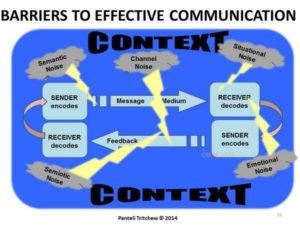 translation.
translation.
Have you ever tried talking to someone who is focusing on something else? You are likely to get a non-sensical response.
In a new culture you often see non-verbal communication, and find it hard to understand their meaning. If you then pick up gestures, and use them wrongly you can end up in all sorts of trouble.
Did you know that ‘Thumbs Up’ in USA, UK, Russia and Australia is a sign of approval, whereas in Latin America, Iran, Iraq and Afghanistan this is interpreted as ‘up yours’! Check out the hand gestures guide below for more gestures.
Do you want updates, tips and tools directly to your in-box? Learn More
Cross-Border Communication Barriers
If you’ve travelled or lived away from your country you know that getting across to someone can be tough. If you’re in a position of responsibility you have a double edge sword if you’re in a different culture.
Common Communication Barriers
You have a job to do, and want to meet the expectations laid out. As the responsible manager you know how communicaiton is a key skill. But what works at home doesnt seem to come across to your staff. The efforts to meet deadlines, get a team working together and manage the role you have assumed are all down to how – and in which way – you communicate. Here below are common communication barriers that may or may not impede your efforts.
 Geographical / Location Barriers
Geographical / Location Barriers
If you are in two different countries the geographical distances make for a communication challenge. Choice of equipment, or social media, can also be a stopper. Not everyone knows how to use Skype, FaceTime, Email or even a Smartphone. Location can create barriers. In an office when working in cubicles; staff shortages; HQ – Field location. These are all examples of separation in time and space that can create huge misunderstandings and perception gaps. Location in time can also mean different generations. Age creates differences of what is presumed to be ‘normal’ communication vs what is not. What do you consider the best way to communicate? By Letter or Instagram?
Language / Jargon / Colloquialism
The language differences, or accents, used  can lead to misunderstandings. Even though you speak the same language the tone of voice, or deeper meaning of words, may not mean the same if your backgrounds are different. If someone tells you something using words you don’t understand, or technical terms that make no sense, or expressions that have no meaning – the barrier is already built. If you then don’t tell the speaker that you don’t get what they are saying the problem becomes two-fold. You have not understood – and the speaker thinks you have.
can lead to misunderstandings. Even though you speak the same language the tone of voice, or deeper meaning of words, may not mean the same if your backgrounds are different. If someone tells you something using words you don’t understand, or technical terms that make no sense, or expressions that have no meaning – the barrier is already built. If you then don’t tell the speaker that you don’t get what they are saying the problem becomes two-fold. You have not understood – and the speaker thinks you have.
 Emotional Barriers
Emotional Barriers
Some find it difficult or hard to express emotions, and certain words have a bigger meaning or ‘cannot’ be used. This limits the conversation as the speaker will not say what they really mean to say, and the receiver will not hear as they block out what is hard.
Distractions / Attention Span
If you get an email  when you are about to take off in an airplane, or speak with lots of surrounding noise you can hardly focus on the message / call. Lack of attention, or even interest, can also block effective communication. Respect for someones time can come in the way here. You perceive the person you are chatting to as being rude, when in effect this may be because s/he was in the midst of writing/reading or simply meditating.
when you are about to take off in an airplane, or speak with lots of surrounding noise you can hardly focus on the message / call. Lack of attention, or even interest, can also block effective communication. Respect for someones time can come in the way here. You perceive the person you are chatting to as being rude, when in effect this may be because s/he was in the midst of writing/reading or simply meditating.
Differences In Perception / Point of View / Prejudices
If you listen while 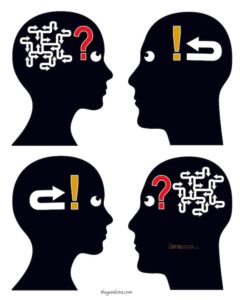 formulating your answer, you have not heard – it is as simple as that. You are not an active listener as you block the communication from get-go because you come from two different places.
formulating your answer, you have not heard – it is as simple as that. You are not an active listener as you block the communication from get-go because you come from two different places.
Maybe your political views are different, or backgrounds? Expectations and prejudices often lead to false assumptions or stereotyping.
People often hear what they expect to hear rather than what is actually said — and jump to incorrect conclusions. The importance of open-ended questions come into play here. If you ask a close-ended question and add ‘right?!’ or ‘isn’t it? — you are feeding the answer you wish to hear and create a barrier to real interaction.
 Physical and Physiological Barriers
Physical and Physiological Barriers
If someone is hard of hearing, or don’t have reading glasses on, this can create barriers to getting communication across. Non-verbal communication can also easily be misunderstood if gestures, body language and posture are different from what one is used to. HSBC had a great marketing campaign called ‘the worlds local bank‘ a few years ago that truly brought this message home. Check out more about gestures below.
If someone is stressed messages are not received, perceived or interpreted the same as when you are in balance. How we manage stress is an important personal skill that affects our interpersonal relationships. Stress can make or break you, and communication breakdowns is a sure sign that something is amiss. When you work away for long periods of time, stress becomes a factor that preys on your overall well-being.
 Cultural Differences
Cultural Differences
Cultural differences exists between nationalities and sometime also between people who live in the same city. The norms of social interaction vary greatly in different cultures, as do the way in which emotions are expressed. For example, the concept of personal space varies between cultures and between different social settings. When you meet a friend in Sweden you tend to hug each other – whereas in Italy a mid-air kiss on each cheek is the done thing.
Tip: Reading an Expat Guide can be a great help!
 Attitudinal Barriers
Attitudinal Barriers
These communication barriers relate to issues that happen in a workplace. Staff – Management breakdowns are common and often a result of communication challenges.
Whether it is poor management, lack of consultation with employees, insufficient training, personality conflicts or the personal attitudes of individual employees the overall result leads to lack of motivation, dissatisfaction and hinders an organisation to move forward. A successful communication at work will help bring about jointly agreed change, new attitude and an overall healthier workplace wellness.
Communication Barriers: 6 Ways Forward
To move forward with your communication you need to sit back and think. Apply some simple thumb rules to your new way of communicating:
#1 Think
Think before you speak, gesture or act in a new culture. Have you read up on what local customs are, and are you aware of the Do’s and Don’ts? UNDP has excellent country guides to look into, and on Amazon.co.uk you can find a great selection of books.
#2 Hand Gestures?
-
Your hand gestures can come across as rude. Learn a bit of what is the local way on non-verbal communication. Start by checking out this guide from cheap flights.co.uk: Global Hand Gestures
#3 Listen
Are you coming across as arrogant? Learn to listen when spoken to, and avoid thinking about your next sentence when engaging in a conversation.
#4 Open-Ended Questions
Open-ended questions are far more effective than the assumption that you want a ‘yes’ or ‘no’ answer.
#5 Keep It Simple
We live in a “verbal” environment. Words constitute the most frequently used tool for communicating. Words usually facilitate communication. However, their careless, improper use in a given situation can create a communication barrier. Who are you speaking to? Adjust your language and use familiar, concrete, short words instead of long sentences with abstract words. Take a look at this cultural negotiating chart, and see how different perceptions can be. Keep it simple, and you will build bridges.
“The meanings of words are not in the words; they are in us.” US Senator, Dr. S. E. Hayakawa
#6 Empathise
Learn to empathise. You can transmit a better message if you can put yourself in the receiver’s place and analyze the message from his viewpoint. The ability to  empathize with someone else may not be easy. If you are to see things from another’s viewpoint, you have to put aside your own prejudices and preconceptions.
empathize with someone else may not be easy. If you are to see things from another’s viewpoint, you have to put aside your own prejudices and preconceptions.
The receiver may be of a different race, creed, educational background, from a different section of the country, or have a different specialty or rank within the organization. Under these circumstances, the task of empathizing with the other member of the communication link is difficult. The task is further complicated if you believe that understanding another’s viewpoint may pose a threat to your own.
Cross Border Communication Bridges
Both time and space (the physical separation between the sender and the receiver) may serve as barriers to effective communication. As you are deeply involved in your everyday challenges, you may even assume that the one you are communicating with will understand you.
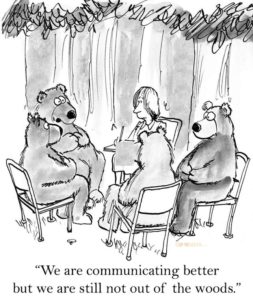 It is time to realise that a communication only takes place when both sender and receiver has coded and decoded each others messages. Therefore – if you wonder why your words and actions are lost in translation – consider it important to change your verbal and non-verbal ways of communicating.
It is time to realise that a communication only takes place when both sender and receiver has coded and decoded each others messages. Therefore – if you wonder why your words and actions are lost in translation – consider it important to change your verbal and non-verbal ways of communicating.
Building Bridges
Communication means trying to see ourselves through the eyes of others (in the communication link).
Using knowledge of a place, experience and by respecting each others differences you get further.
By developing empathy with the people to whom we will be directing messages, and learning to think before we send out a communication attempt we can reach an understanding.
Real communication means building bridges across gender, cultural differences and experience levels. Listen, Speak, Show or Hear, Talk and Relate. Communicate.
What are your experiences when working far away? Can communication get trickier? How did you get over the most common communication barriers? Please share your experiences in the comment box below.
For more about working far away, and lifestyle changes you can do every day follow The GOODista by signing up here below – for free of course!
Recommended and Related:
- 7 Cs of Communication – Infographic
- Cognitive Dissonance: A Trigger for Change– thegoodista.com
- Listening Facts You Never Knew – Ragan PR Daily
- 6 Powerful Communication Tips – fastcompany.com
- Communication Charts Help You Negotiate in Different Cultures – psfk.com

